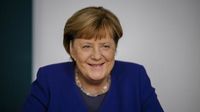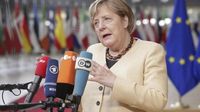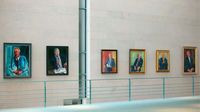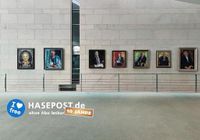Angela Merkel, the former Chancellor of Germany, has yet to decide who will create her official portrait for the gallery of former Chancellors in the Federal Chancellery. According to a spokesperson, Merkel is expected to make a decision in 2025, as she prefers to take her time after serving sixteen years in office. The gallery currently features portraits of seven Chancellors, concluding with her predecessor, Gerhard Schröder.
Despite Merkel having been out of office for over three years, her portrait is still conspicuously absent from the gallery. This absence has raised questions about the timeline for her portrait, especially considering that the last handover of a Chancellor's portrait occurred 17 years and eight months ago, a record duration. The previous longest interval was 17 years between Helmut Schmidt and Helmut Kohl.
In July 2007, Gerhard Schröder, during a ceremony for his own portrait, jested to Merkel, "Irgendwann werden Sie neben mir hängen," meaning "At some point, you will hang next to me." This lighthearted remark has taken on a new significance as the years pass without Merkel's image being added to the gallery.
Merkel's spokesperson emphasized that the decision regarding the artist is a personal one for the former Chancellor, who wishes to reflect on her time in office before making such a choice. This thoughtful approach is not just about selecting an artist; it symbolizes Merkel's desire to craft her legacy on her own terms. In an interview from 2021, she acknowledged the lengthy process, stating, "The picture will be made. But I have not yet made a decision. I have learned that there were Chancellors who did this only after several years."
Merkel's absence from the gallery is particularly notable given that she was the first female Chancellor of Germany. The upcoming decision about her portrait could potentially break the trend of male artists who have historically created the Chancellor's portraits, from Konrad Adenauer's by Hans Jürgen Kallmann to Gerhard Schröder's by Jörg Immendorf.
Meanwhile, current Chancellor Olaf Scholz has also not yet made a decision about his own portrait. He indicated during a discussion with students last year that he has some ideas in mind for his portrayal but has not disclosed any specifics. The uncertainty surrounding both portraits raises the question of whether Scholz's image will be added to the gallery before or after Merkel's.
The gallery serves as a historical testament to Germany's leadership, and the absence of Merkel's portrait has left a noticeable gap. Visitors to the Chancellery expect to see a complete representation of the nation's leaders, and the ongoing delay in adding Merkel's image has sparked conversations about the future of the gallery.
As Merkel prepares to make her decision, the legacy of her tenure continues to be a topic of discussion. The evolution of public opinion regarding her leadership has shifted significantly since she left office. Initially celebrated, Merkel faced criticism for Germany's reliance on Russian gas and the country's response to the Ukraine conflict. Her recent autobiography has further fueled discussions about her time in power, and this context may influence her choice of artist.
Historically, the portraits of Chancellors have not only captured their likenesses but also reflected their self-perception and how they wish to be remembered. Each artist's style and approach tell a story about the Chancellor's legacy. Merkel's choice will undoubtedly carry weight, as she considers how she wants to be portrayed in the annals of German history.
As the gallery awaits the addition of Merkel's portrait, it is also preparing for the potential arrival of Friedrich Merz, who is expected to succeed Scholz. This transition will add another layer of complexity to the gallery's future, as space will need to be made for new portraits. The current arrangement may require adjustments to accommodate the portraits of both Merkel and Merz.
In summary, the ongoing absence of Angela Merkel's portrait in the Chancellor's gallery highlights not only the personal nature of her decision but also the broader implications for how Germany remembers its leaders. As the nation looks to the future, the portraits in the gallery will continue to serve as a reminder of the past, each one telling a unique story of leadership.







